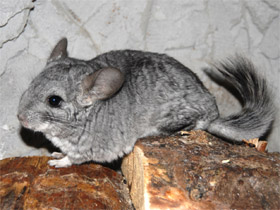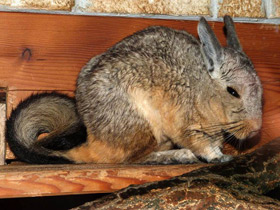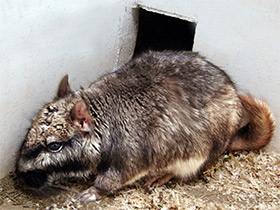The family Chinchillidae
The genus Lagidium
The northern viscacha (Lagidium peruanum)
The family Chinchillidae is in the order Rodentia and consists of the chinchillas, the viscachas, and their fossil relatives. This family is restricted to southern and western South America, mostly living in mountainous regions of the Andes but one species living on plains. They are medium to large-sized rodents, weighing from 800 g (28 oz) to 8 kg (18 lb), with strong hind legs and large ears and a bushy tail. All species have thick, soft fur, which is considered valuable in some cultures.
Characteristics
Members of the family Chinchillidae are somewhat rabbit or squirrel-like rodents varying in weight from 0.5 to 8 kilograms (1.1 to 17.6 lb). They have large eyes, medium-sized ears, soft dense fur and short bushy tails. The forelegs are shorter than the hind legs. The forefeet have four toes while the hind feet have four small-clawed toes in Lagidium and Chinchilla but three large-clawed toes in Lagostomus, a digging species. Their dental formula is 1.0.1.3/1.0.1.3 and their incisors grow continually throughout their lives. Chinchillids are generally brownish-grey or grey on the dorsal (upper) surface and pale on the ventral (under) surface. Plains viscachas have distinctive black and white markings on their faces.
Distribution
The Chinchillidae are native to South America. Chinchillas and mountain viscachas live in remote mountainous regions of Chile and Peru, on rocky surfaces and among boulders. Plains viscachas are found in the plains of Argentina, from the Gran Chaco area southwards to Patagonia.
Behaviour
Members of this family are herbivorous and live in colonies of up to several hundred individuals. Plains viscachas live in extensive networks of burrows on plains where it is said that ten viscachas can eat as much as does one sheep. Mountain viscachas and chinchillas live in craggy upland regions where they inhabit crevices among rocks and are skilled climbers. Although they can jump, they mostly move about by walking or running. They use vocalizations to communicate with each other, especially the plains viscachas.
Status
Both species of chinchillas are listed by the IUCN as being "critically endangered" and may be extinct in the wild. They were at one time relatively common but have been overexploited by hunters catching them for the fur trade. The plains viscacha is rated as being of "least concern" as it seems tolerant of habitat disturbance and although some populations have been eliminated locally through pest control measures and hunting, others have expanded into newly cleared areas. Both the northern and southern mountain viscachas are also considered of "least concern" as they have a wide range and are locally abundant in some areas.
Classification
Three extant and three fossil genera are currently recognized:
- †Eoviscaccia incertae sedis;
- †Incamys;
- Subfamily Chinchillinae;
- Chinchilla – chinchillas;
- Lagidium - mountain viscachas;
- Subfamily Lagostominae;
- Lagostomus - plains viscachas;
- †Pliolagostomus;
- †Prolagostomus.
The genus Lagidium
Lagidium is a genus of rodents in the family Chinchillidae.
Taxonomy
Prior to 2009, most authors considered there to be three species of mountain viscachas. However, taxonomy sometimes differs by authors (e.g. Lagidium peruanum is included within Lagidium viscacia according to Anderson 1997). Four species are currently recognised:
- Ecuadorean mountain viscacha (Lagidium ahuacaense;
- Northern viscacha (Lagidium peruanum);
- Southern viscacha (Lagidium viscacia);
- Wolffsohn's viscacha (Lagidium wolffsohni).
Externally, Lagidiums somewhat resemble rabbits: they also have long ears, but, however, they also have long tails. Front and hind limbs of these cute animals are four-toed with elongated narrow feet and blunt weak claws. Their body hair is thick and soft, except for the tail, where it is rather coarse. The back of Lagidium is dark yellow or dark grey, the ventral side of the body is usually whitish, yellowish or light grey, and the tip of the tail is black or reddish brown. These South American rodents inhabit dry, rocky areas with very poor vegetation. Lagidium are found at altitudes from 900 to 5000 metres above sea level, often staying near water bodies. Lagidium live in colonies of several individuals up to 80 animals. Their shelters are rock crevices, hollows under stones; they rarely dig their own burrows. Lagidium nimbly climb on rocks and between stones. A small family group consisting of 2-5 individuals usually stays in the same shelter. Lagidiums feed on grasses, mosses and lichens. Their mating period is from October to November. Pregnancy lasts about 3 months, and during the year there may be 2 or 3 litters, usually one calf each. Lagidiums reach sexual maturity at about 7 months of age. Their life span in the wild is 2-3 years, but in captivity they can live up to 20 years.
The northern viscacha (Lagidium peruanum)
The northern viscacha (Lagidium peruanum) is a species of viscacha, a rodent in the family Chinchillidae.
Distinguishing features
Lagidium peruanum is a fairly large rodent, the length of its body reaches 30-45 cm, the weight ranges from 900 to 1600 g. Externally, this animal resembles a rabbit, but its hind legs are much longer than those of real rabbits. Lagidium peruanum has ears about 8 cm long, the outer edge of which is somewhat wrapped inwards and the end is rounded. The ears are covered with sparse wool on the outside and are almost naked on the inside. Wool of Lagidium peruanum is very soft and long, individual hairs at the root are white, at the tip dirty-white, mixed with yellowish-brown. Thus, in general, the fur is ashy-grey in colour, which is somewhat lighter on the sides and turns yellowish. The tail is studded below and on the sides with short hairs, white and black, and towards the end entirely black; in the upper part the hairs are brownish-black, long and ruffled.
Habitat
Lagidium peruanum has a fairly wide range in the Central Andes; it is common in central and southern Peru and northern Chile, and possibly in Bolivia around Lake Titicaca. Vizcachas are found at altitudes from 300 metres (on the ocean coast) to 5000 metres above sea level in rocky habitats.
Reproduction
The gestation period for Lagidium peruanum is 140 days, with the female usually giving birth to one calf. In a year each female gives birth to 2-3 mature cubs, which are able to eat grass immediately after birth. The milk-feeding period lasts about eight weeks. The cubs remain with their mother for a relatively long time. It is not uncommon for two cubs born at different times to live in a burrow with the female, and the older calf, along with the younger one, may suckle milk, although it is practically unnecessary.
Social behaviour
A 1946 study in Peru (Pearson, 1948) showed that Lagidium peruanum lead a colonial lifestyle, and solitary individuals are almost never found in settlements of this species. Colonies of 10-20 individuals are more common, and the largest colonies have up to 80 individuals. In each colony there are elementary groupings of 2 to 5 individuals occupying one burrow. Members of such a group can be easily identified by observing how they gather together and bask in the sun. Aggressive conflicts between groups have not been recorded even if the distance between their shelters does not exceed a few metres. No outward signs of territory defence were also found. Each pair or family group occupies its own habitat, and neighbouring individuals make no attempt to invade "alien" territory. Avoidance of entrances to neighbouring plots was not associated with aggressive reactions of their hosts, who made no attempts to pursue "outsiders". The spatial structure of the settlement remained unchanged, at least for several months.
Shortly before the onset of the mating season, females become aggressive towards males and semi-adults and either expel them from their burrows or move to another burrow themselves. In such refuges 2-3 females in the state of oestrus may congregate. During the mating season, each male may mate with several females, just as females mate with several males. However, some males retain attachment to constant partners and drive away other rivals. In pregnant females, aggression subsides and group members reunite.
Status
The northern viscacha is common within suitable habitat in its range. The population size is relatively stable, and although it is hunted locally for food, no other significant threats have been identified, so the IUCN lists the species as being of Least Concern in its Red List of Threatened Species.


















































